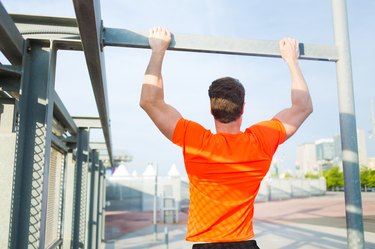
A standard pullup is an upper body builder that requires nothing more than a pullup bar. A regular front pullup builds your upper arms, shoulders, abs and back muscles, but it may become mundane over time. Adding variations to your pullup routine, such as the behind-the-neck, or rear, pullup is one way to prevent boredom and add intensity to your workout routine.
Pullups and Muscles
Video of the Day
The upper back contains the latissimus dorsi, teres major and trapezius, while your shoulders and upper arms contain the deltoids, biceps and triceps. You work all of these muscles whenever you perform a pullup. While both front and rear pullups focus on the shoulders, upper arms and back, front pullups are less intense than rear pullups. Once you've mastered front pullups, you can move on to rear pullups to intensify your workout and continue to build up your upper body.
Video of the Day
Muscles Targeted With Rear Pullups
The upper back receives a greater emphasis in the rear pullup. The latissimus dorsi actually starts in the lower back then moves up to the top in a "V" shape. The trapezius, rhomboids major and minor, pectoralis, biceps, teres major and abs are also worked during a rear pullup. The traps and rhomboids sit between the shoulder blades at the top of the back. The pecs are in the chest. The teres major runs from the bottom of the shoulder blade over to the center of the back. The biceps brachii sit on the front of the upper arms. All of these muscles receive a more intense workout in a rear pullup, including your abs, which also contract to help stabilize the spine and produce force during the exercise.
Form with the Pullup
Sloppy form leads to muscle injury and compromised progress. When doing rear pullups, you need to be aware of your body position and range of motion. Begin by grasping the bar with an overhand, wider than shoulder-width grip. To balance your body, bend your knees and cross your lower legs behind your body. Keeping your back straight and abs tight, pull yourself up toward the bar and move your head underneath. Once your neck lightly touches the bar, slowly lower yourself back down and repeat. Fully extend your arms when you lower yourself down.
How to Add Resistance
Over time, the weight of your body might not be enough for you to continue to achieve favorable results with your pullups. As a rule, if you can perform more than 12 reps of an exercise, you should increase the resistance, or in the case of pullups, your weight. You have several ways to do this with behind-the-neck pullups. You can strap on ankle weights, wear a weighted vest, pinch a dumbbell between your lower legs or wear a weighted backpack. A weighted vest has small compartments that hold weights to increase the resistance and intensity of your workout.
Pullup Bar Alternatives
If you don't have access to a pullup bar, you can still do behind-the-neck pullups. An open truss in a garage or barn, sturdy tree branch or durable C-clamps fastened to a floor joist in a basement or under a deck will work instead. Wear gloves if you use one of these alternatives to protect your hands. You can also purchase a portable pullup bar that attaches to the inside of a door.